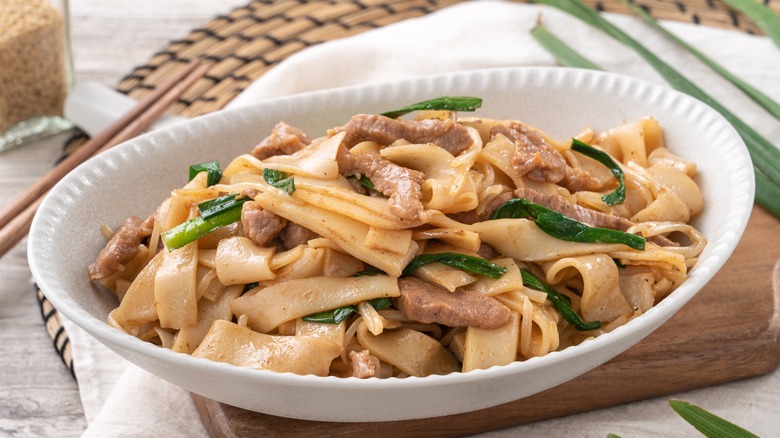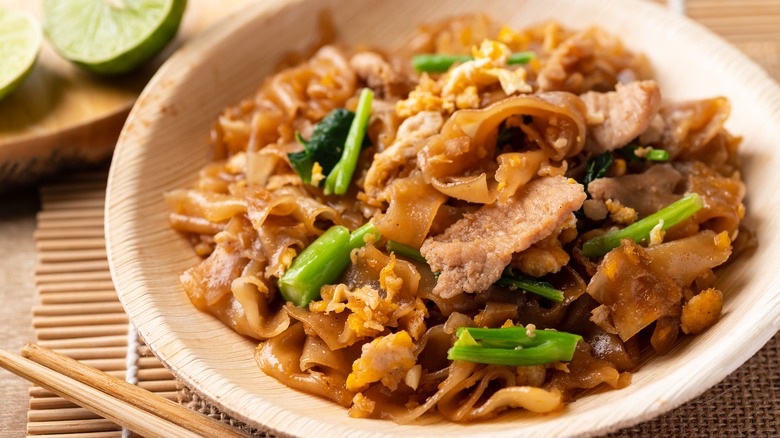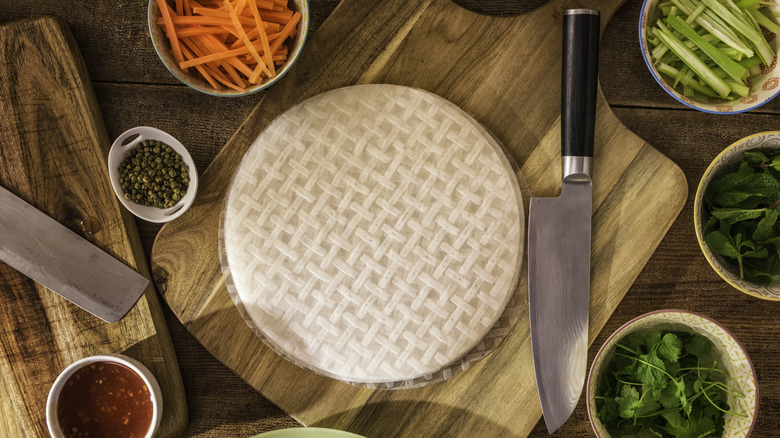Out Of Rice Noodles? Use One Starchy Alternative
Rice noodles, which are quick-cooking, gluten-free, and delicious, are a staple in recipes from across the Asian continent, from Chinese chow fun to Vietnamese pho. You can buy them in a variety of styles and widths at Asian markets, but what if a craving strikes and your go-to store is closed for the night? In a pinch, you can make a substitute out of rice paper.
Typically used for dishes like spring rolls or dumplings, rice paper wraps are made using similar ingredients to rice noodles. After softening them in water, they can be cut into long strips and used in dishes that call for flat, wide noodles. Just stack a few sheets of the paper together and cover them in warm water. They will fuse together, and you can then microwave them for one to two minutes (still in the water), or steam them. You'll have a sheet of thick, soft paper that can be cut into noodle shapes with a knife.
When starved for time, you could probably skip the microwaving or steaming step, as most rice paper is designed to fully rehydrate after a 30-second soak in warm water. Cold water is preferred when using the paper as a wrapper, but hot water activates more of the starches to produce a softer texture similar to noodles. Just make sure to mix your noodles with a sauce or oil soon as they're ready, or they could fuse into a gelatinous blob.
How to use rice paper noodles
Rice paper noodles are fun and easy to make, but they do have their limitations. Both rice noodles and rice paper use a base of rice flour, but the paper often has tapioca added, while true rice noodles lack it. Rice paper-based noodles will satisfy your craving, but the texture won't be exactly the same, as the tapioca tends to make them much chewier.
Also, while rice noodles can range from thick and flat ho fun to super thin and delicate rice vermicelli, this substitute will produce wider noodles, since you have to cut them by hand. You can experiment with different thicknesses and lengths, but unfortunately, thin spaghetti-like strands are probably off the table. Luckily, rice paper noodles make up for this by being just as versatile as their authentic counterparts.
Your DIY noodles can be used in any number of dishes, from grilled shrimp pad thai to turmeric tofu noodles with dill or a savory chicken pad see ew. For a 10-minute dinner, serve them with a sauce of tahini, lime juice, honey, and soy sauce, along with leftover shredded chicken, ground beef, or your preferred choice of protein. To go even simpler, top them with a generous spoonful of chili crisp and a soft-boiled egg. Or, look to Vietnamese summer rolls as inspiration for a light noodle dish with shredded cabbage, carrot, cucumber, jalapeño, and cilantro, tossed in a creamy peanut butter dressing.
More alternatives to rice noodles
If you want to experiment even more, there are other substitutes you can use in place of rice noodles. Shirataki noodles, which are common in Japanese cuisine, are made from a soluble fiber called glucomannan. This fiber is extracted from a plant called konjac root and combined with water to make noodles that are so low in calories, they're often marketed as "miracle noodles." Like rice noodles, shirataki are gluten-free and highly versatile, though they have very little flavor and are more rubbery and Jell-O like in comparison. They work best in dishes with lots of other flavors and textures to liven them up.
There are also glass noodles, which are known by several other names, including cellophane noodles, saifun, mung bean noodles, or bean thread noodles. These gluten-free noodles are made from mung bean starch, sometimes supplemented with tapioca or corn starch, and have a more slippery texture than rice noodles. Either shirataki or glass noodles should work well in recipes that call for rice noodles — just note that they are not an exact imitation, so feel free to poke around and see which you like best!



